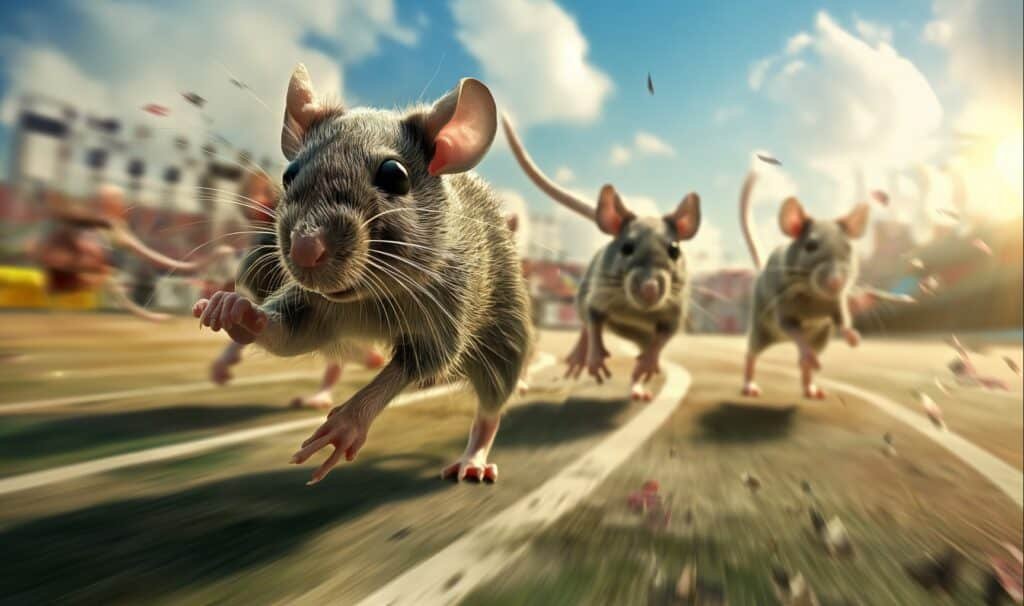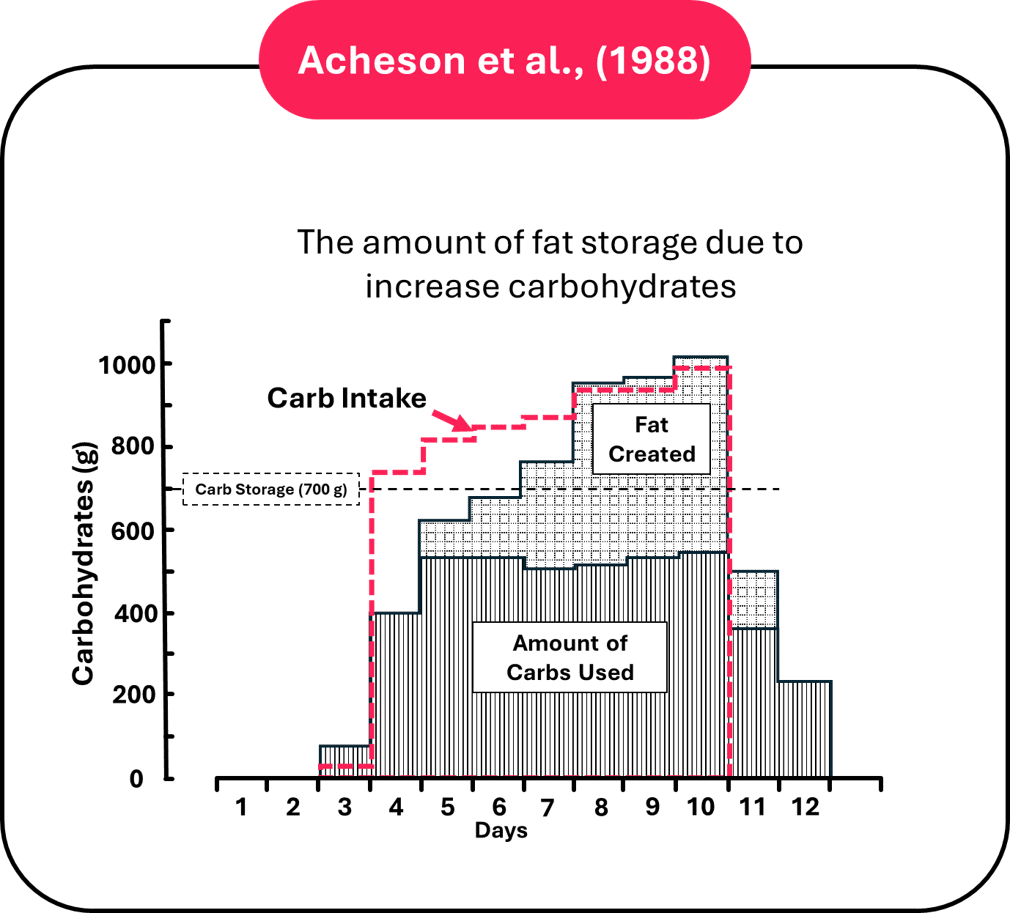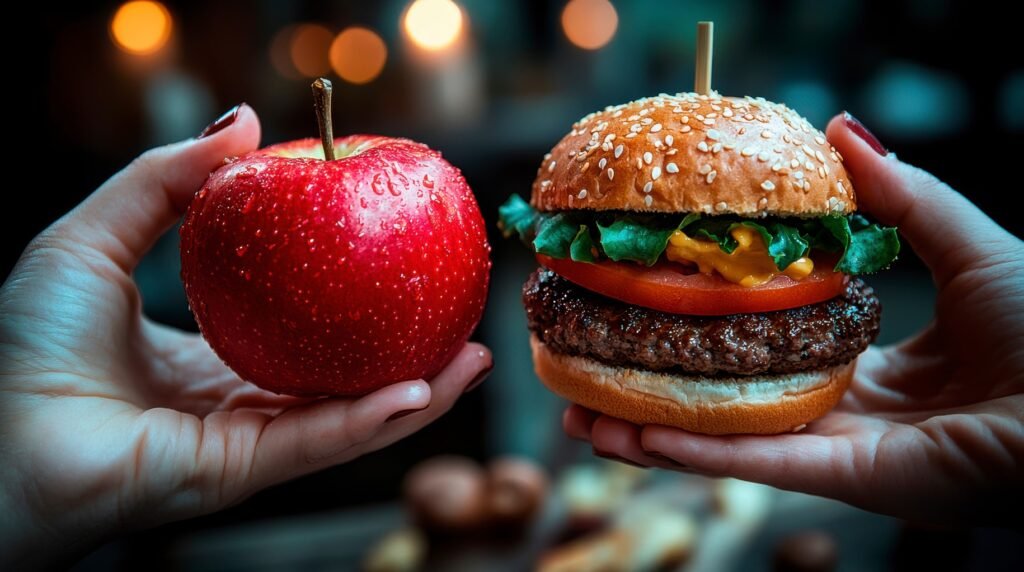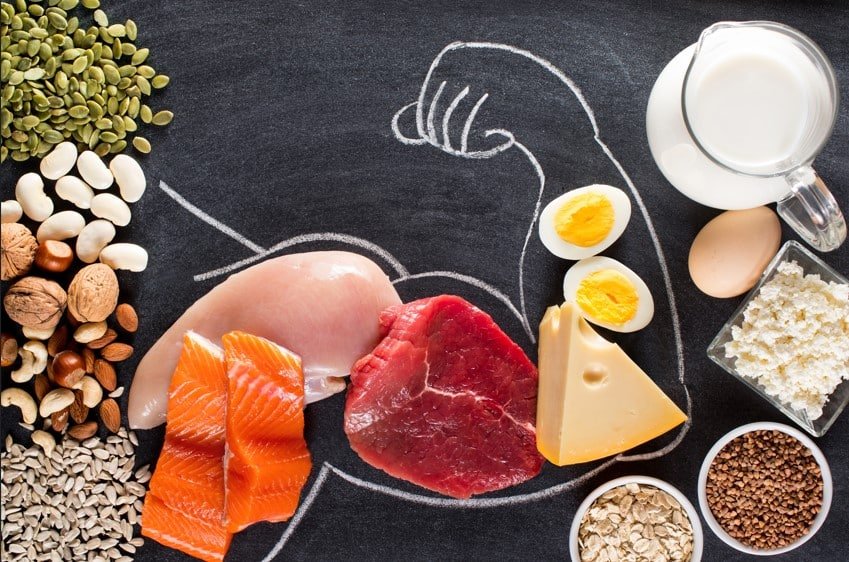Ah, carbohydrates – the macronutrient everyone loves to hate. You’ve probably heard it a thousand times: “Carbs make you fat!” But is this really true, or is it just another nutritional myth that’s been blown out of proportion? Let’s dive into the science and separate fact from fiction.
First things first, carbohydrates are not the enemy. They’re a preferred energy source that our bodies use for energy. But like that friend who always overstays their welcome, too much of anything can be problematic. The real question isn’t whether carbs make you fat, but rather how they fit into the bigger picture of energy balance and overall health.
Now, before you toss out your bread and pasta, let’s look at what the science actually says. We’ll explore some fascinating studies on both rats and humans, delve into the intricacies of how our bodies process carbohydrates, and even discuss what happens when you stuff yourself with carbs like there’s no tomorrow. Trust me, it’s more interesting than it sounds.
Table of Contents
- What Are Carbohydrates?
- Carbohydrates and Energy Balance
- Insulins Function
- The Rat Race: What Animal Studies Tell Us
- Human Evidence: Carbs in the Real World
- The Glycogen Factor: Storage and De Novo Lipogenesis
- Carbohydrates and Metabolic Health
- Carbohydrates and Exercise Performance
- Practical Applications: Carbs in Your Diet
- Personalization: One Size Doesn’t Fit All
- Debunking Common Carbohydrate Myths
- Conclusion: The Verdict on Carbs and Fat Gain
Key Takeaways:
- Carbohydrates alone don’t make you fat – excessive calorie intake does.
- The type and quality of carbohydrates matter more than simply cutting them out.
- Your body’s response to carbohydrates is complex and involves factors like glycogen storage and de novo lipogenesis.
- Individual factors play a significant role in how your body processes carbohydrates.
- A balanced approach to carbohydrate intake, considering both quantity and quality, is key for most people.
So, buckle up and prepare to have your carb-related misconceptions challenged. By the end of this article, you’ll be armed with the knowledge to make informed decisions about your carbohydrate intake. And who knows? You might even start looking at that slice of bread a little differently.

The Science Behind Carbohydrates and Weight Gain
Ok, it’s time to separate fact from fiction and understand what’s really going on when you bite into that bagel or slurp up some spaghetti.
What Are Carbohydrates?
Carbohydrates are one of the three macronutrients our bodies use for energy, alongside proteins and fats. They’re the body’s preferred fuel source, providing 4 calories per gram. But not all carbs are created equal.
Simple carbohydrates, like those found in sugar and refined grains, are quickly broken down and absorbed by the body. They give you that quick energy boost but can leave you crashing later. Complex carbohydrates, found in whole grains, vegetables, and legumes, take longer to digest and provide a more sustained energy release.
The glycemic index (GI) and glycemic load (GL) are tools we use to measure how quickly and how much a food raises blood sugar levels. High GI foods spike blood sugar rapidly, while low GI foods cause a more gradual increase. The GL takes into account both the GI and the amount of carbohydrate in a serving, giving us a more complete picture of a food’s impact on blood sugar.
Carbohydrates and Energy Balance
Here’s where things get interesting. The fundamental principle of weight management is energy balance. If you consume more energy (calories) than you expend, you’ll gain weight. If you expend more than you consume, you’ll lose weight. It’s that simple… and that complicated.
Carbohydrates play a role in this energy equation, but they’re not the sole villain in the weight gain story. In fact, gram for gram, carbohydrates contain less than half the calories of fat. So why do carbs get such a bad rap?
One reason is that carbohydrate-rich foods are often easy to overeat. Think about how easy it is to polish off a bag of chips or a plate of pasta. These foods are often calorie-dense but not necessarily nutrient-dense, making it easy to consume excess calories without feeling full.
Insulins Function
Another factor is the insulin response. When we eat carbohydrates, our blood sugar rises, triggering the release of insulin. Insulin helps shuttle glucose into our cells for energy or storage. Some argue that high insulin levels promote fat storage and inhibit fat burning. While there’s some truth to this, it’s an oversimplification of a complex process.
The misconception that carbs alone cause weight gain likely stems from these factors, combined with the rapid water weight fluctuations associated with carbohydrate intake. When we eat carbs, our bodies store some as glycogen in the muscles and liver. Each gram of glycogen is stored with about 3 grams of water. This can lead to quick weight changes on the scale, but it’s not the same as fat gain.
| Macronutrient | Calories per Gram | Primary Function |
|---|---|---|
| Carbohydrates | 4 | Energy, brain function |
| Protein | 4 | Tissue repair, enzymes |
| Fat | 9 | Energy storage, hormone production |
To truly understand the impact of carbohydrates on weight, we need to look at the bigger picture. It’s not just about the carbs themselves, but how they fit into your overall diet, lifestyle, and individual physiology.
In the next sections, we’ll dive into some fascinating studies that shed light on how different diets, including those varying in carbohydrate content, affect weight and body composition. Spoiler alert: it’s not as straightforward as “carbs make you fat.” But don’t worry, by the end of this article, you’ll have a much clearer understanding of how to approach carbohydrates in your diet for optimal health and weight management.

The Rat Race: What Animal Studies Tell Us
Let’s dive into the world of whiskers and lab coats, shall we? While we can’t exactly ask rats to fill out food diaries, these furry little test subjects provide valuable insights into the complex relationship between carbohydrates and weight gain. But before you start eyeing that cheese wheel with suspicion, let’s examine what the rodents have to teach us about carbs and fat.
The Minderis et al. Study
Picture this: a bunch of chubby mice hitting the gym and going on diets. Sounds like a Pixar movie, right? Well, it’s actually a groundbreaking study by Minderis and colleagues that’s giving us some food for thought about carbs and weight loss.
In this rodent weight loss bootcamp, researchers put obese mice on various diets, all with the same calorie restriction but different macronutrient ratios. They had three groups:
- The Low-Fat Diet (LFD) crew: 20% fat, 60% carbs, 20% protein
- The Low-Carb Diet (LCD) gang: 60% fat, 20% carbs, 20% protein
- The High-Protein Diet (HPD) squad: 30% fat, 35% carbs, 35% protein
Now, if carbs were the sole villain in our weight gain story, we’d expect the low-carb mice to be the biggest losers. But hold onto your cheese, because that’s not what happened.
All three groups shed significant weight, with the LFD mice dropping 28.7%, the LCD mice losing 21.8%, and the HPD mice shedding 29.2%. Surprise, surprise – the low-fat, high-carb mice lost just as much weight as their protein-packed pals, and even more than the low-carb group.

But weight isn’t everything (don’t we all know it). The researchers also looked at fat loss, muscle mass, and various health markers. Again, all groups showed improvements, with no significant differences in fat loss between the diets.
Here’s where it gets interesting: while all groups improved their glucose tolerance, the LCD mice actually had higher blood glucose levels after eating compared to the other groups. It seems those low-carb mice might have developed a bit of a sweet tooth.
| Diet Group | Weight Loss | Fat Loss | Glucose Tolerance |
|---|---|---|---|
| LFD (High Carb) | -28.7% | Significant | Improved |
| LCD (Low Carb) | -21.8% | Significant | Improved, but higher post-meal glucose |
| HPD (High Protein) | -29.2% | Significant | Improved |
These findings throw a wrench in the gears of the carbohydrate-insulin model of obesity, which suggests that carbs are the primary driver of fat storage. If that were true, our low-carb mice should have been the slimmest of them all. Instead, it seems that calorie restriction, rather than carb restriction, was the real MVP in this weight loss game.
Limitations of Animal Studies
Now, before you start planning an all-pasta diet based on these results, let’s pump the brakes a bit. While our rodent friends can provide valuable insights, we can’t just assume that what works for Mickey will work for you and me.
First off, mice and humans have some key differences in metabolism and physiology. Mice, for instance, have a much higher metabolic rate relative to their body size. They also don’t have to deal with the complexities of human behavior, like stress eating during a Netflix binge.
Moreover, this study was relatively short-term, lasting only six weeks. In the human world, that’s barely enough time to remember where you put your gym membership card. Long-term effects and sustainability of different diets can vary significantly.
Additionally, these were obese mice being put on a calorie-restricted diet. The results might be different for lean mice or mice (or humans) who are not in a calorie deficit.
Despite these limitations, animal studies like this one are still incredibly valuable. They allow us to control variables in ways that would be impossible (or highly unethical) in human studies. Want to see what happens when you overfeed someone by 200% for weeks on end? Good luck getting that past an ethics board for human subjects, but with mice, it’s all in a day’s work.
These studies also help us generate hypotheses and identify potential mechanisms that we can then investigate further in human trials. They’re like the opening act that sets the stage for the main event.
So, what’s the takeaway from our rodent weight loss reality show? It seems that when it comes to shedding pounds, calories are king, regardless of whether they come from carbs, fats, or proteins. But remember, we’re not mice, and weight loss is just one piece of the health puzzle.
In the next section, we’ll see how these findings translate to the complex world of human nutrition. Spoiler alert: it’s not as simple as cheese in a maze, but it’s a whole lot more interesting.

Human Evidence: Carbs in the Real World
While rat studies provide valuable insights, nothing beats human data when it comes to understanding our own species. Let’s investigate a study by Kerksick et al. study, a 14-week investigation that puts carbs under the microscope in a way that’s relevant to your average Jane or Joe trying to shed some pounds.
The Kerksick et al. Study
Let me paint this picture for you: 141 sedentary, obese women, average age 38.7 years, with BMIs hovering around 35. These aren’t lab rats; these are real people with real lives, jobs, and families. The researchers divided them into six groups, each following a different diet and exercise regimen:
- VLCHP: Very Low Carbohydrate, High Protein + exercise
- LCMP: Low Carbohydrate, Moderate Protein + exercise
- HCLP: High Carbohydrate, Low Protein + exercise
- HED: High Energy Diet + exercise
- ND: No Diet + exercise
- CON: Control (no diet, no exercise)
The exercise component wasn’t some crazy, unattainable routine. We’re talking about 30-minute sessions of circuit-style resistance training, three times a week. Something most people could realistically fit into their schedules.
Now, here’s where it gets interesting. The diets ranged from 1,200 to 2,600 calories per day, depending on the phase and group. This isn’t some extreme, unsustainable crash diet scenario. It’s a realistic approach to calorie restriction that people might actually stick to.
So, what happened after 14 weeks? Drum roll, please…
- VLCHP group lost an average of 5.0 ± 4.2 kg
- LCMP group shed 3.7 ± 3.3 kg
- HCLP folks dropped 3.6 ± 3.8 kg
- HED participants lost 3.5 ± 3.4 kg
- ND group said goodbye to about 2.5 kg
- CON group? They actually gained a smidge, 0.5 ± 2.9 kg
Now, before you jump on the low-carb bandwagon, hold your horses. While the VLCHP group lost the most weight numerically, the differences between the diet groups weren’t statistically significant. In other words, all the calorie-restricted diets led to weight loss, regardless of their carbohydrate content.
Additionally, protein has a higher thermic effect (implying that eating more protein raises metabolic processes). Thus, this could explain why the VLCHP group lost more weight.

Interpreting the Results
Let’s break this down. All the groups that combined calorie restriction with exercise saw significant improvements in body composition. We’re talking smaller waists, less body fat, the whole nine yards. But here’s the kicker: there were no significant differences between the VLCHP, LCMP, and HCLP groups in terms of these improvements.
What does this tell us? It screams that calorie restriction and exercise are the real MVPs when it comes to weight loss and body composition changes. The macronutrient distribution? It’s more of a supporting actor than the star of the show.
But wait, there’s more. The study also looked at some health markers:
- Lipid profiles didn’t change significantly across the board.
- The VLCHP group saw reductions in fasting insulin and HOMA-IR (a measure of insulin resistance).
- All calorie-restricted groups experienced drops in leptin levels, a hormone involved in hunger regulation.
Here’s a table summarizing the key findings:
| Group | Weight Loss (kg) | Waist Circumference | Fasting Insulin | Leptin |
|---|---|---|---|---|
| VLCHP | -5.0 ± 4.2 | Significant decrease | Significant decrease | Significant decrease |
| LCMP | -3.7 ± 3.3 | Significant decrease | No significant change | Significant decrease |
| HCLP | -3.6 ± 3.8 | Significant decrease | No significant change | Significant decrease |
| HED | -3.5 ± 3.4 | Moderate decrease | No significant change | Moderate decrease |
| ND | -2.5 (approx.) | Slight decrease | No significant change | Slight decrease |
| CON | +0.5 ± 2.9 | No change | No change | No change |
What’s the takeaway here? It’s not about demonizing carbs or putting them on a pedestal. The real story is that various dietary approaches, when combined with regular exercise, can lead to significant improvements in body composition and health markers. The key is finding an approach that works for you, that you can stick to in the long run.
Remember, this study was conducted in free-living conditions. These women weren’t locked in a lab; they were living their lives, dealing with work stress, family obligations, and all the other curveballs life throws. And guess what? They still saw improvements.
So, the next time someone tries to sell you on the idea that carbs are the enemy, or that you need to cut them out completely to lose weight, you can confidently tell them, “That’s not what the science says.” Because in the real world, with real people, it’s not about vilifying a single macronutrient. It’s about finding a balanced approach that you can maintain, combining sensible eating with regular physical activity.
In the grand scheme of things, carbs aren’t making you fat. Overconsumption of calories, regardless of their source, combined with a sedentary lifestyle, is the real culprit. So go ahead, enjoy that sweet potato with your chicken breast. Just make sure you’re moving your body and keeping an eye on your overall calorie intake. Your body will thank you for it.

The Glycogen Factor: Storage and De Novo Lipogenesis
Alright, let’s dive into the essentials of how our bodies handle carbohydrates when we go overboard. We’re talking about a fascinating process that happens when you decide to have an all-you-can-eat pasta night, followed by a dessert buffet, and then maybe a midnight snack of cereal. Yeah, we’ve all been there.
A study by Acheson et al. gives us a peek into what happens when we stuff ourselves with carbs like there’s no tomorrow. These mad scientists basically force-fed three brave (or perhaps foolish) young men with massive amounts of carbohydrates for a week. We’re talking about starting at 3,642 calories on day one and ramping up to a whopping 4,930 calories by day seven. That’s a lot of bread, folks.
Now, here’s where it gets interesting. Our bodies are pretty smart when it comes to storing energy. The first thing they do when faced with this carb avalanche is to stock up on glycogen. Think of glycogen as your body’s version of a backup battery. The study found that these guys could store up to about 15 grams of glycogen per kilogram of body weight. That’s roughly 500 grams of carbs tucked away before things start to get… well, fatty.
But what happens when your glycogen stores are full? That’s when the real magic happens. The body switches gears and starts turning those excess carbs into fat through a process called de novo lipogenesis. It’s like your body saying, “Alright, if you’re gonna keep sending carbs my way, I’m gonna turn them into fat for a rainy day.”
In the study, this fat-making factory kicked into high gear after about 4-5 days of carb overfeeding. By the end, these poor souls were churning out about 142 grams of new fat per day. Over the course of the study, they gained about 580 grams of fat from this process alone. That’s more than a pound of new fat, created from scratch, just because they couldn’t say no to carbs.

Adapted from Acheson et al., (1988) depicts the metabolic changes that occurred by eating a large influx of calories from carbohydrates.

Adapted from Acheson et al., (1988). This figure shows how carbohydrates metabolism changed during the study. Additional fat wasn’t stored until well above 500 g per day.
However, despite this massive influx of carbohydrates, the body managed to keep fasting blood glucose levels normal. How? By cranking up insulin production and enhancing glucose disposal mechanisms. Now, before you swear off carbs forever, let’s put this into perspective. This study was an extreme case. Unless you’re planning on doubling your calorie intake and eating nothing but carbs for a week, you’re probably not going to see these kinds of effects.
| Day | Calorie Intake | Carbohydrate % | Fat Gain from De Novo Lipogenesis |
|---|---|---|---|
| 1-3 | 1361-1994 | 10% | Negligible |
| 4 | 3642 | 86% | Minimal |
| 7 | 4930 and greater | 86% | ~142g/day |
What does this mean for weight management? Well, it shows that our bodies are pretty adaptable. They can handle short-term carb overload without immediately turning into a blob of fat. The glycogen storage acts as a buffer, allowing us to enjoy the occasional carb-heavy meal without dire consequences.
However, it also demonstrates that consistently overeating carbohydrates can lead to fat gain over time. The body’s ability to convert excess carbs to fat means that no, you can’t just eat all the pasta you want without consequences. Sorry to burst that bubble.
But here’s the good news: under normal eating conditions, most of us aren’t coming close to maxing out our glycogen stores. This means there’s usually room for some carbohydrate in your diet without triggering significant fat gain. It’s all about balance and not consistently overfeeding.
Remember, weight fluctuations after a carb-heavy meal are often due to increased glycogen storage and the water that comes with it. Each gram of glycogen holds onto about 3-4 grams of water. So that 2-pound weight gain after your pasta feast? It’s mostly water weight, not fat.
In the end, this study shows us that while our bodies are remarkably adaptable, they’re not magical. Consistently overeating, regardless of the macronutrient, will eventually lead to weight gain. But it also demonstrates that carbohydrates aren’t inherently fattening. It’s the overall calorie excess that’s the culprit.
So, the next time someone tries to demonize carbs, you can hit them with some science. Just maybe don’t use it as an excuse to recreate this study at your local all-you-can-eat buffet. Your body (and your wallet) will thank you.

Carbohydrates and Metabolic Health
Carbohydrates often get a bad rap in the world of nutrition, but their impact on metabolic health is far more nuanced than many people realize. Let’s dive into the complex relationship between carbs, blood sugar, insulin, and overall metabolic function.
Blood Sugar and Insulin Response
When you eat carbohydrates, your body breaks them down into glucose, which enters your bloodstream. This triggers the release of insulin, a hormone that helps cells absorb glucose for energy or storage. It’s a beautifully orchestrated process, but like any complex system, it can go awry.
The rate at which carbohydrates affect blood sugar varies. Simple carbs, like those found in sugary drinks or white bread, cause rapid spikes in blood glucose. Complex carbs, such as those in whole grains or vegetables, lead to a more gradual increase. This difference is crucial for metabolic health.
Frequent, dramatic blood sugar spikes can lead to insulin resistance over time. Imagine your body’s cells as nightclub bouncers. At first, they readily let glucose (the partygoer) in when insulin (the VIP pass) shows up. But after too many wild parties (blood sugar spikes), the bouncers get jaded. They start ignoring insulin, leaving glucose to wreak havoc in the bloodstream.
This insulin resistance is a precursor to type 2 diabetes. However, it’s important to note that carbohydrates themselves don’t cause diabetes. It’s the overconsumption of calories, often from refined carbs and added sugars, combined with a sedentary lifestyle that typically leads to this condition.
Interestingly, the Acheson study we discussed earlier showed that even with massive carbohydrate overfeeding, fasting blood glucose remained normal. The body ramped up insulin production to handle the excess carbs, demonstrating its remarkable ability to adapt. However, this adaptation came at a cost – insulin levels skyrocketed, and plasma triglycerides increased tenfold.

Carbohydrates and Exercise Performance
Now, let’s talk about something carbs are undeniably good at – fueling exercise. Carbohydrates are the body’s preferred energy source for high-intensity activities. When you’re sprinting, lifting heavy weights, or playing a intense game of basketball, your body primarily relies on glucose and stored glycogen for fuel.
The Acheson study revealed that the human body can store about 15 grams of glycogen per kilogram of body weight. For a 70 kg (154 lb) person, that’s over 1 kg (2.2 lbs) of stored carbohydrate energy! This glycogen is like your body’s turbo boost, ready to power you through intense exercise.
During prolonged endurance activities, your body will gradually deplete these glycogen stores. This is why marathon runners often talk about “hitting the wall” – it’s the point where glycogen stores run low, and performance suffers dramatically.
Adequate carbohydrate intake is crucial for replenishing these glycogen stores post-exercise. This is particularly important for athletes or anyone engaging in regular, intense physical activity. A low-carb diet might leave you feeling like you’re running on fumes during your workouts.
However, it’s not just about quantity – timing matters too. Consuming carbohydrates immediately after exercise can enhance glycogen replenishment and support recovery. This is why you often see athletes chugging sports drinks or eating bananas right after a competition.
| Carbohydrate Intake | Effect on Exercise Performance |
|---|---|
| Low (< 20% of calories) | May impair high-intensity performance, reduce glycogen stores |
| Moderate (40-50% of calories) | Supports most exercise needs, maintains glycogen stores |
| High (> 60% of calories) | May enhance endurance performance, maximizes glycogen stores |
In conclusion, carbohydrates play a crucial role in metabolic health and exercise performance. They’re not inherently “good” or “bad” – their impact depends on the type, quantity, and context of consumption. A balanced approach, focusing on whole food sources and appropriate portions, can support both metabolic health and athletic performance.
Remember, your body is an incredibly adaptive machine. It can handle a wide range of carbohydrate intakes, from very low to very high. The key is finding the balance that works best for your individual needs, goals, and lifestyle. And of course, always pair your carb intake with regular physical activity – your metabolism will thank you!

Practical Applications: Carbs in Your Diet
Alright, let’s cut through the noise and get to the meat of the matter – or should I say, the whole grain of the issue? We’ve dissected the science, now it’s time to put that knowledge to work in your kitchen and on your plate.
Quality Matters: Choosing the Right Carbs
Listen up, because this is where the rubber meets the road. Not all carbs are created equal, and if you’re still equating a slice of whole grain bread with a handful of gummy bears, we need to have a serious talk.
Whole, unprocessed carbohydrates should be your go-to. These bad boys come packed with fiber, vitamins, minerals, and even some protein. They’re the complete package, like that overachiever in high school who was good at everything – annoying, but undeniably beneficial.
Here’s a quick rundown of nutrient-dense carb sources that deserve a spot on your plate:
- Quinoa: This pseudo-grain is a protein powerhouse, containing all nine essential amino acids.
- Sweet potatoes: Loaded with beta-carotene and fiber, they’re nature’s candy with benefits.
- Berries: Antioxidant bombs that’ll make your cells sing with joy.
- Oats: The breakfast of champions, packed with beta-glucan for heart health.
- Beans and lentils: Fiber, protein, and enough variety to keep things interesting.
Now, I’m not saying you need to swear off processed carbs entirely. We’re all human, and sometimes you just need a slice of pizza. But make those whole, unprocessed sources the foundation of your carb intake, and you’ll be doing your body a solid.
Portion Control and Timing
Here’s where things get a bit tricky. Portion sizes aren’t one-size-fits-all, but I can give you some ballpark figures to work with. For most adults, a serving of carbs is about:
- 1/2 cup of cooked grains or starchy vegetables
- 2 slices of bread
- 1 small piece of fruit
However, your needs may vary based on your activity level, body composition, and goals. A 300-pound linebacker is going to need a lot more carbs than a sedentary office worker. Use these as starting points and adjust based on your hunger and energy levels.
As for timing, it’s not just about what you eat, but when you eat it. Here’s a quick guide:
| Timing | Carb Intake | Reasoning |
|---|---|---|
| Pre-workout | Moderate | Fuel for performance |
| Post-workout | Higher | Replenish glycogen stores |
| Before bed | Lower | Less immediate energy needed |
Remember, these are guidelines, not hard and fast rules. Your body isn’t a machine that runs on a strict schedule, so be flexible and listen to your hunger cues.

Personalization: One Size Doesn’t Fit All
Now, here’s where I’m going to contradict everything I just said – because nutrition is funny like that. The truth is, the best diet is the one you can stick to. Some people thrive on higher carb intakes, while others feel better with less. Your job is to find what works for you.
Factors that can influence your carb needs include:
- Activity level and type of exercise
- Body composition goals
- Metabolic health
- Personal preferences and cultural background
Don’t be afraid to experiment. Try different carb intakes and see how you feel. Track your energy levels, hunger, and performance. It’s like being a scientist, but instead of a lab coat, you’re wearing sweatpants and the experiment is delicious.
Remember, sustainability is key. If you’re miserable on a low-carb diet, it doesn’t matter how “effective” it might be – you won’t stick to it long-term. Find an approach that fits your lifestyle and doesn’t make you want to dive headfirst into a vat of pasta after a week.
In the end, carbohydrates aren’t your enemy. They’re just another tool in your nutritional toolbox. Use them wisely, choose quality sources, and find the balance that works for you. And if anyone tries to tell you that carbs are evil, just smile and offer them a sweet potato. They clearly need the energy to fuel their misguided crusade.
Debunking Common Carbohydrate Myths
Let’s tackle some of the most persistent myths about carbohydrates that have been floating around the fitness and nutrition world. It’s time to separate fact from fiction and put these misconceptions to rest once and for all.
“Carbs Make You Fat”
This is perhaps the most pervasive myth about carbohydrates, and it’s about as accurate as saying water makes you wet – technically true under certain conditions, but missing the bigger picture. The truth is, any macronutrient consumed in excess can contribute to weight gain. It’s not carbs alone that are the culprit; it’s the overall caloric balance.
Let’s look at the science. Remember our rat friends from the Minderis et al. study? Those little rodents lost weight on high-carb, low-carb, and high-protein diets alike. The key factor wasn’t the macronutrient distribution; it was the caloric restriction. In humans, the Kerksick study showed similar results. Participants lost weight on various diets, including those high in carbohydrates, as long as they maintained a caloric deficit.
But here’s where it gets interesting. Carbohydrates do have a unique property that can lead to short-term weight fluctuations. When we eat carbs, our bodies store them as glycogen in the muscles and liver. Each gram of glycogen is stored with about 3-4 grams of water. This is why you might see the scale jump up after a carb-heavy meal or drop quickly when starting a low-carb diet. But this isn’t fat gain or loss – it’s primarily water weight.
“Low-Carb Diets Are Superior for Weight Loss”
Ah, the low-carb vs. high-carb debate – a topic hotter than a fresh batch of sweet potato fries. Low-carb diets have had their moment in the sun, with proponents claiming they’re the holy grail of weight loss. But is this really the case?
Short-term studies often show that low-carb diets can lead to rapid initial weight loss. However, this is largely due to the water weight loss we just discussed. When we look at longer-term studies, the differences between low-carb and other diets tend to even out.
A meta-analysis published in the Journal of the American Medical Association in 2014 compared low-carb and low-fat diets. The result? Both approaches led to similar weight loss over the long term. The key factor wasn’t the carb content; it was adherence to the diet.
Here’s a table summarizing some key findings from various dietary approaches:
| Diet Type | Initial Weight Loss | Long-term Weight Loss | Adherence Rate |
|---|---|---|---|
| Low-Carb | Rapid (including water weight) | Similar to other diets | Varies |
| Low-Fat | Moderate | Similar to other diets | Varies |
| Balanced | Moderate | Similar to other diets | Often higher |
The takeaway? The best diet for weight loss is the one you can stick to long-term. For some, that might be low-carb. For others, it might include a moderate amount of carbohydrates. The key is finding an approach that’s sustainable for you.
“All Carbs Are Created Equal”
This myth is like saying all exercises are equally effective – it completely misses the nuances. Not all carbohydrates have the same effect on your body. The glycemic index (GI) and glycemic load (GL) of foods can significantly impact how your body responds to carbohydrates.
High GI foods, like white bread or sugary snacks, cause rapid spikes in blood sugar and insulin. This can lead to energy crashes and increased hunger. On the other hand, low GI foods, such as whole grains, legumes, and most fruits, provide a slower, more sustained release of energy.
The Acheson study we discussed earlier provides some insight here. Even with massive carbohydrate overfeeding, the body maintained normal fasting blood glucose levels. However, insulin levels increased significantly to manage this carbohydrate load. Over time, consistently high insulin levels can lead to insulin resistance, a precursor to type 2 diabetes.
So, while a calorie is a calorie when it comes to weight gain or loss, the type of carbohydrate you consume can have significant impacts on your health and how you feel throughout the day.
“Carbs Are Bad for Athletes”
If I had a dollar for every time I heard this myth in the locker room, I’d have enough to buy a lifetime supply of energy gels. The truth is, carbohydrates are crucial for athletic performance, especially in high-intensity or endurance activities.
Glycogen, the storage form of carbohydrates in our muscles, is the primary fuel source for high-intensity exercise. When glycogen stores are depleted, performance suffers. This is why you’ll see marathon runners downing carbohydrate gels during races.
Does this mean athletes should gorge on pasta before every workout? Not necessarily. Carbohydrate needs vary based on the type, intensity, and duration of exercise. But it does mean that completely cutting carbs is likely to hurt, not help, athletic performance.
In conclusion, carbohydrates aren’t the dietary demons they’re often made out to be. They’re an essential part of a balanced diet and can be particularly beneficial for active individuals. The key is choosing high-quality carbohydrate sources, managing portion sizes, and considering your individual needs and goals. Remember, in the world of nutrition, context is king, and blanket statements rarely hold up under scientific scrutiny.

Conclusion: The Verdict on Carbs and Fat Gain
After diving deep into the scientific evidence, it’s clear that carbohydrates aren’t the dietary villains they’re often made out to be. The notion that “carbs make you fat” is an oversimplification that ignores the complexities of human metabolism and nutrition.
Let’s recap the key findings from our scientific journey:
- The Minderis et al. rat study showed that caloric restriction, not macronutrient distribution, was the primary driver of weight loss and metabolic improvements.
- The Kerksick et al. human study demonstrated that various macronutrient distributions can lead to similar weight loss outcomes when combined with caloric restriction and exercise.
- The Acheson et al. study revealed the impressive capacity of the human body to store and utilize carbohydrates, with de novo lipogenesis only occurring under extreme overfeeding conditions.
These studies collectively paint a picture that’s far more nuanced than “carbs make you fat.” Instead, they point to the fundamental principle of energy balance: weight gain occurs when we consistently consume more calories than we burn, regardless of whether those calories come from carbohydrates, fats, or proteins.
Quality matters. The type and source of carbohydrates you consume can significantly impact your health and weight management efforts. Whole, unprocessed carbohydrates provide essential nutrients and fiber, contributing to satiety and overall health. It’s the refined, highly processed carbs that often lead to overconsumption and potential weight gain.
Personalization is key. Your individual needs, activity level, and metabolic health all play a role in determining the optimal carbohydrate intake for you. There’s no one-size-fits-all approach, and finding a sustainable eating pattern that works for you is crucial for long-term success.
Context is crucial. Carbohydrates serve important functions in our bodies, particularly for fueling high-intensity exercise and supporting athletic performance. Demonizing an entire macronutrient group overlooks these benefits and can lead to unnecessary dietary restrictions.
In conclusion, carbohydrates don’t inherently make you fat. Weight gain is a result of chronic energy surplus, not the consumption of a specific macronutrient. A balanced approach that includes quality carbohydrates, along with proteins and healthy fats, can support weight management, metabolic health, and overall well-being.
So, the next time someone tells you to avoid carbs to lose weight, you can confidently explain that it’s not that simple. The science is clear: carbs aren’t the enemy, and they can be part of a healthy, balanced diet that supports your weight and health goals.




Thank you I have just been searching for information approximately this topic for a while and yours is the best I have found out so far However what in regards to the bottom line Are you certain concerning the supply